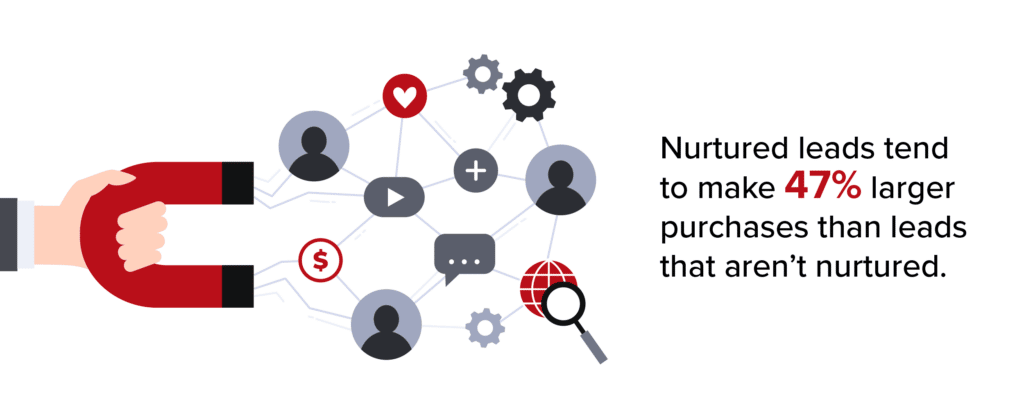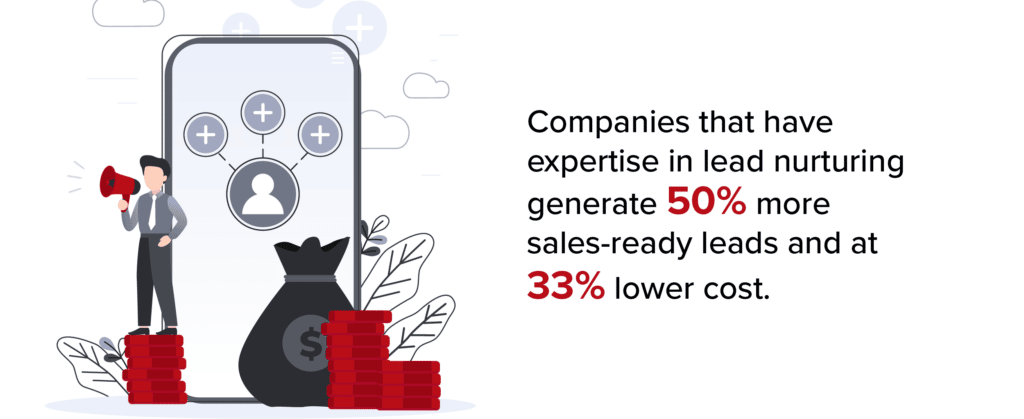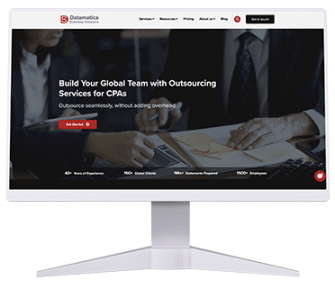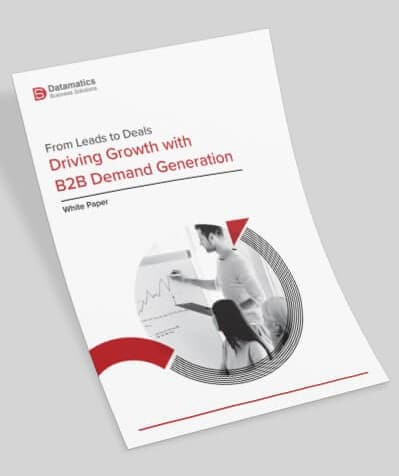Many organizations leverage inbound marketing strategies to generate business leads. However, not every lead generated will be ready to make the purchase. This leaves the majority of leads in the funnel far from being converted into sales. This is where the importance of effective B2B lead nurturing strategies becomes paramount.
Nurturing campaigns can have a positive impact on the outcomes of your marketing efforts – Customer engagement, brand loyalty, better conversions and more revenue, to name a few.
What is Lead Nurturing?
It is the process of developing relationships with potential customers at every stage of the sales and marketing funnel.
An ideal lead nurturing process anticipates the buyer’s needs based on multiple characteristics such as their role, title, industry, etc., and where they stand in the buying process. Nurturing helps keep the prospects engaged by sharing the most relevant content (such as eBooks, technical briefs, and webinars) tailored to their situation.
When done smartly, lead nurturing helps set the tone for strong brand loyalty in the long run. With B2B lead nurturing, companies can exponentially convert unqualified leads to opportunities while driving more revenue.
What is Lead Nurturing Strategy?
Lead nurturing strategy is a well-thought-out process of establishing and building meaningful relationships with prospective customers. The primary objective is to increase customer engagement and educate them about your products and services on a deeper level, helping them make better buying decisions. Lead nurturing often includes providing prospects with relevant and high-quality content and all the information they need throughout their buying journey.

10 Best B2B Lead Nurturing Strategies
In a B2B environment, the sales cycles can be longer, and stakes are higher. Adopting effective nurturing campaigns becomes even more crucial. Here are the top 10 best B2B lead nurturing best practices:
1. Leverage Highly Targeted Content
At any given point, different buyers are at different stages of the buying cycle. Here, the one-size-fits-all approach will prove futile. It is necessary to cater to every buyer’s unique needs and provide targeted content to help them make informed decisions.
Creating an Ideal Customer Profile will help you understand their needs and expectations better. This information will help you make an assortment of targeted content that can be leveraged to nurture customers based on their interests, demographics, buying triggers, and their position in the buying journey. Using targeted content is one of the best ways to nurture leads and significantly improve your marketing outcomes.
2. Deploy Omnichannel Lead Nurturing Strategies
Gone are the days when B2B lead nurturing best practices were limited to sending emails. Your nurturing campaigns should never be limited to one or two channels. Instead, you must utilize the multiplier effect of different channels to create a better impact and improve the chances of sales conversion.
By implementing omnichannel nurturing strategies, you can reach out to your prospects on their preferred platforms, at their preferred time. Effective multi-channel lead nurturing tactics involve a combination of automation, email marketing campaigns, social media marketing, paid ads targeting and retargeting, dynamic website content, mobile marketing and direct sales outreach.
3. Optimize Every Touchpoint
The buying journey consists of multiple touchpoints, from the point when the prospects first get to know about your products and services till the point when they actually make the buying decision. The best B2B lead nurturing strategies deliver content that helps the prospect gain valuable insights about your offerings and answers to their questions and concerns.
You should optimize every possible touchpoint and ensure you add value to your prospects during every stage of their buying journey. Website content resources, client testimonials, social media presence, digital advertisements, email marketing campaigns, mobile marketing campaigns are some notable touchpoints that can influence the buying decision.
Master the Art of Lead Qualification
4. Setup Timely Follow-up Cycle
A timely follow-up email or a phone call is a great way to convert inbound marketing leads into marketing qualified opportunities. The chances of converting a lead into a sales opportunity are exponentially higher if immediate contact is established with the lead. If you reach out to the lead once and fail to follow-up, there is a high chance they might forget about your products and services.
However, you must be careful about the intervals in the follow-up cycle. Reaching out too often too soon can create a negative brand image and push the lead away. Striking the right balance between the intervals is effective. You should provide new, relevant and helpful information every time you reach out to them.
5. Personalize Email Nurture Strategy
Though you may use multiple channels to optimize your B2B lead nurturing strategies, email campaigns must form a crucial part of your nurturing campaigns. Email marketing is one of the highly-effective lead nurturing tactics as it tends to provide the best ROI. Personalization of the email nurture strategy can help you reap more benefits for your efforts.
You can also set up trigger emails for website visitors. These emails are sent whenever a visitor completes actions like downloading content resources, clicking on certain links, visiting particular pages and demonstrating more engagement with the content.
6. Align your Sales & Marketing Strategies
For your B2B lead nurturing strategies to be successful, alignment of sales & marketing becomes important. When sales & marketing are on the same page, lead nurturing campaigns tend to be more successful with improved sales conversions.
Your sales team should know the leads that are being nurtured by the marketing team. This streamlines the follow-up process as the sales team prioritizes those leads. Similarly, the marketing team should be aware of the leads that are passed to the sales teams so that they can adjust their marketing efforts accordingly. By aligning sales & marketing teams you avoid repetition of efforts and optimize the lead nurture process.

7. Audit Your List
Aside from basic processes, a majority of companies are unable to comprehend the specific qualification of their leads (visitor, SQL, MQL, or unqualified).
Audit and update your active leads’ status by leveraging your definitions of SQLs and MQLs, buyer personas, as well as analytics.
While this shouldn’t be carried out frequently, it’s to know your contact database isn’t full of erroneous data and bad leads.
8. Limit Gated Content
When trying to attract more leads, it’s wise to avoid using gated content everywhere.
Gating highly valuable content, such as a detailed annual report, may result in fewer leads. However, such leads may be a better fit further in the buyer’s journey. On the other hand, allowing the lead to preview the content is a great way to attract more leads.
9. Create More Lead Capturing Opportunities
Aside from highly valuable content assets and landing pages, consider different ways to snag potential lead info. One such way to generate leads is through networking. Experiment with various tactics apart from gated content and email campaigns, such as Facebook running contests or organizing giveaways.
Revisiting your buyer personas and evaluating where leads congregate can help you to understand where you can run paid lead capturing campaigns on social media platforms.
 Select an element to maximize. Press ESC to cancel.
Select an element to maximize. Press ESC to cancel. Select an element to maximize. Press ESC to cancel.
Select an element to maximize. Press ESC to cancel.10. Refresh Your Processes
Many leads are just browsing when they first engage with your company; thus they probably won’t get converted into customers right away. However, with a thorough B2B lead nurturing process, a majority of those leads will be ready to buy.
But can your team figure out who those leads are?
If not, ensure you’re up aligned with your company’s definitions of MQL and SQLs, and revisit your lead scoring strategy. A strong lead-scoring method can assist you in prioritizing your leads, allowing you to save time on prospects who are unlikely to convert.
Conclusion
There is no one technique that will work for every prospect. This is why you should consistently measure, analyze and improvise your B2B lead nurturing strategies. Market demands and customer expectations keep on changing. Your strategies should evolve to cater to these changing demands.
Onboarding a demand generation service provider will help you streamline your lead nurturing campaigns. You can utilize their expertise and knowledge to implement B2B lead nurturing best practices and improve your business outcomes.
Remember, if you fail to nurture the leads, you miss the opportunity to connect with them when they need your products or solutions and convert them into your customers.
 Select an element to maximize. Press ESC to cancel.
Select an element to maximize. Press ESC to cancel.Frequently Asked Questions
Lead nurturing helps in developing and maintaining relationships with customers at every stage of their journey, usually through marketing and communications messaging. Automated lead nurturing uses software to send messages that are triggered by customer behavior or predetermined schedules.
The goal of lead scoring is to assist salespeople in prioritizing their workload, increasing conversion rates, and shortening the sales cycle time. Whereas Lead Nurturing is the process of ongoing communication between a company and its prospects (Lead Nurturing) or customers (Customer Nurturing).
According to Hubspot, SEO (14%), email marketing (13%), and social media (12%) are the three best lead sources for B2B businesses. On the other hand, social media, traditional advertising, and email generate more leads for B2C.
Blog posts, social media posts, and SEO are some examples of lead generation methods (search engine optimization). The goal of lead generation is to guide prospects through the sales funnel to the final sale and serves as the first step in the buying process.

Paul van de Kamp



